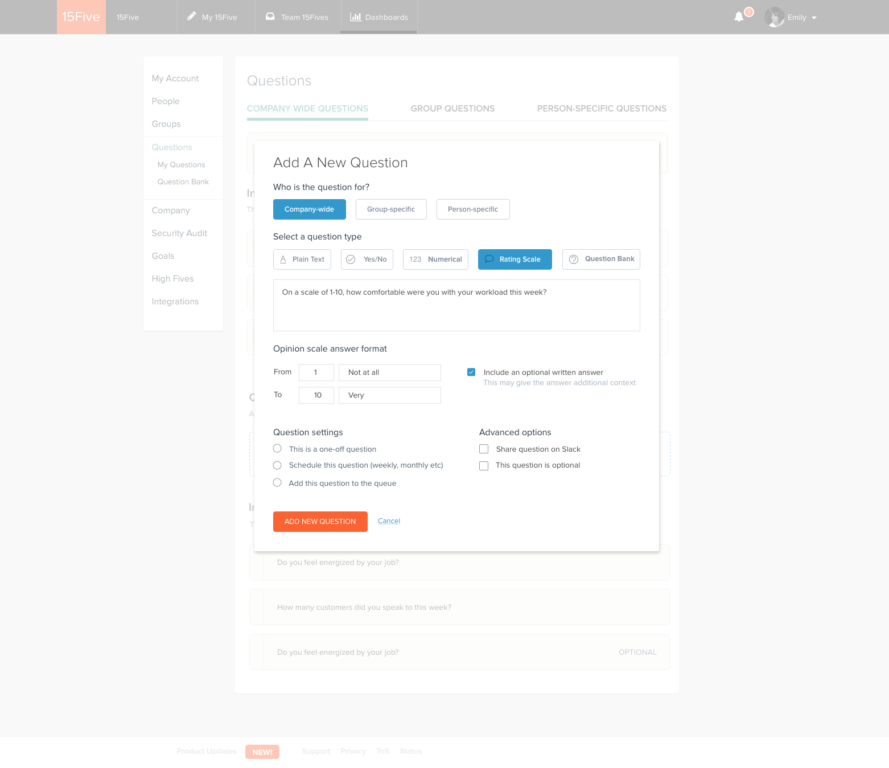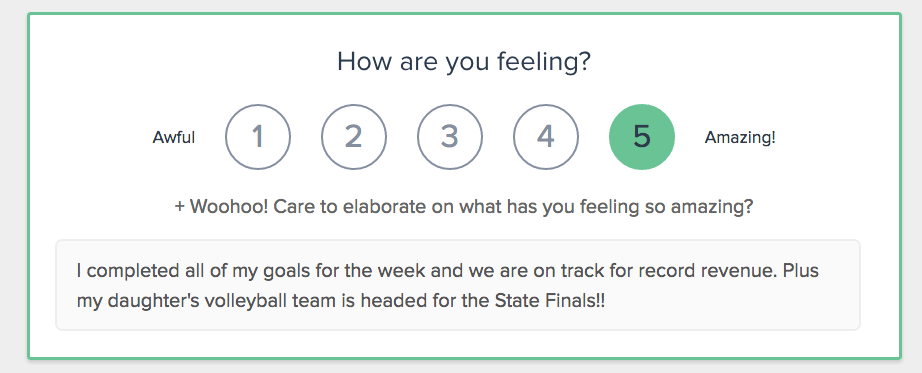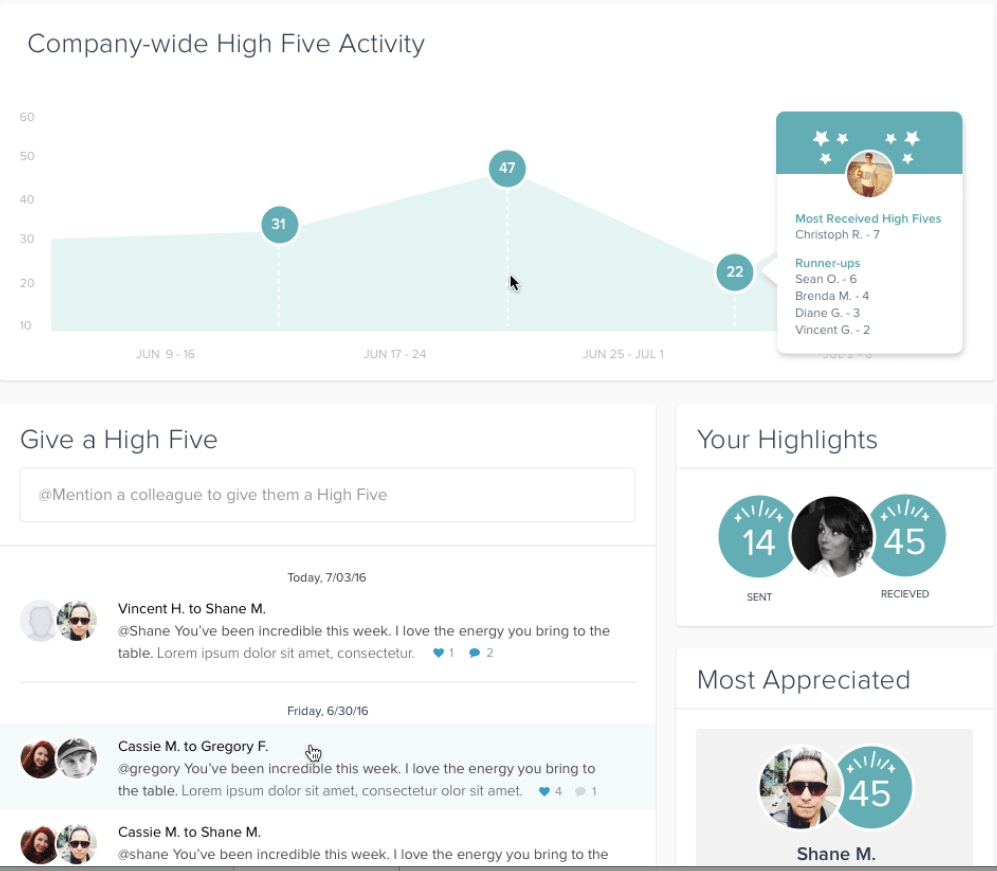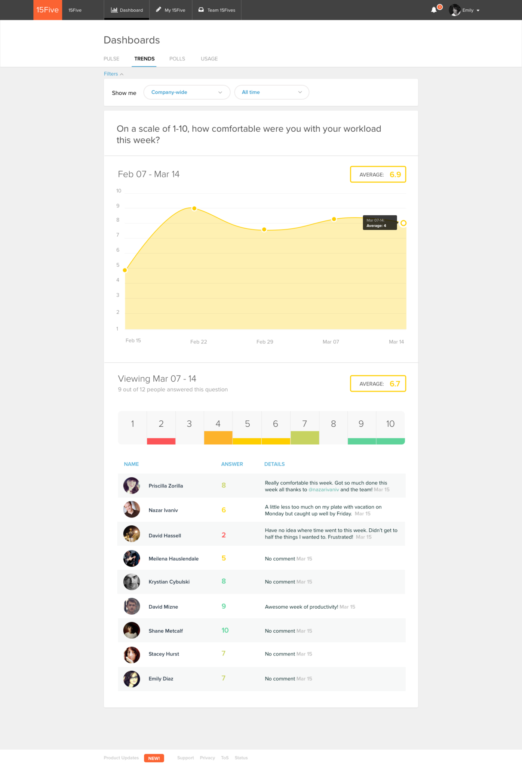15Five 2.0: Putting The People Back In People Analytics
What is more valuable to a manager, team data they can measure or qualitative employee feedback?
The quick answer…both are equally necessary components of a complete people management strategy. Which is why today we are introducing quantitative question types and visual dashboards to aggregate and analyze data about your employees. You’ll want to ensure that you are utilizing a data-driven employee management platform as part of your ongoing performance management strategy.
Extra! Read all about it!
I think of data like a news headline, and qualitative feedback like the in-depth news story that follows. The headlines are important, catching our eye and drawing us in, making us aware of information that we wouldn’t otherwise know. This is especially vital if that information indicates a problem. For example, legislation being introduced that will raise taxes by 4%.
While informative, that snippet is problematic because it lacks context. We don’t know what the legislation is proposing and if that outweighs the financial impact. Without context we can’t do anything about it, there’s no resolution, and an uneasy feeling sits with us. It’s only when we read the full article that we get more detailed information. We can ask questions of others, delve deeper and take action by voting on the initiative.
And that philosophy is the crux of why we are releasing our new metrics questions. Our CEO, David Hassell, shares his views on why we created these new features:
We’ve always had a stance that what’s often missing is qualitative feedback. Many different dashboards and business analytics tools are available, but what’s missing is listening to employees to hear the subtleties of their experiences that provide context and depth. The combination of data and employee feedback produces something really powerful.
For example, you can ask employees “How are you feeling?” on a 1-5 scale. When that number trends downward over time, you can go back and review the 15Five submitted during that week when things started slipping. You can view individual responses to qualitative questions like, “Are there any obstacles you are facing and how can I help?” Then you can manage to those people based on their answers. Providing clarity or support with a few struggling employees can raise how everyone feels and performs all over the organization.
We have been looking to create these new metrics questions and dashboards for some time, and are excited for this release.
By the numbers
With our new metrics questions and dashboards we can provide greater value to businesses, especially on larger teams, where managers and executives need to understand trends and aggregated data for hundreds or thousands of employees. They can track these trends across teams or the entire organization, and then ask targeted open-ended questions of individual employees. Those questions become conversations, which in-turn become actions that impact employee performance and engagement, as well as business outcomes like revenue growth.
New quantitative question types are now available along with visual dashboards to aggregate and analyze your data. You can ask, measure, and manage just about anything you can think of. Ask a question on a 1-10 scale, a yes/no, access our question bank, or ask a simple numerical question.
A great example is, “How many times have you gone to lunch or gotten a drink with a colleague this week?” We recently started asking this and it created awareness around team camaraderie. In just 2-3 weeks, we saw a considerable uptick. It’s remarkable how many brilliant ideas can come out of a team lunch.

Pulse Check
This question is incredibly powerful, giving managers and executives an at-a-glance view of company morale. Each week, Pulse Check asks your people “How are you feeling?” on a 1-5 scale. The Pulse dashboard aggregates the data, giving you insight into how your team and organization are feeling, so you can help them feel their best.

[CTA “Want to know the “pulse” of your company? 15Five offers a lightweight solution to quickly check-in with your employees every week.”]
High Five!
Speaking of feeling your best, nothing lifts spirits quite like soliciting triumphs worth celebrating. One easy way is with High Fives.
Employees simply @Mention a colleague and share why that person earned their praise over the past week. The High Five Dashboard displays all the High Fives throughout the organization, as well as who the top giver and receiver were in a given time period. This helps with morale and also lets managers easily pinpoint their rockstars.

What’s trending now?
The strongest predictor of someone’s future performance, is their past behavior. When you ask a metrics question more than once, that data will populate in the Trends Dashboard. Rich analytics and charts provide information on morale, performance and productivity to gain a deeper understanding of your people at all levels in the organization.

A note on People Analytics
People Analytics continues to be a somewhat nebulous term. Deloitte’s Josh Bersin defines it in this Wall Street Journal Article:
“People analytics brings together a company’s employee-related data to solve specific business problems in such areas as sales productivity, retention, fraud, and customer satisfaction.”
But relying too heavily on data can be disastrous. According to the father of Emotional Intelligence, Daniel Goleman, in this Harvard Business Review article: “A manager…can force his people to work hard to meet quarterly targets, for example, while destroying the emotional climate that sustains the life-blood of any organization.” Goleman continues with the example of Google, a company synonymous with Big Data, that refuses to use data exclusively when masking employee decisions like when to give promotions.
If you have conversations with employees as problems arise, so much can be addressed before full-fledged breakdown. Asking questions uncovers when people are struggling beyond their capacity or are aware of things that need improvement.
Of course, being purely anecdotal is not without its pitfalls either. Morale can be high and people can feel great while the company slowly slips into collapse.
Employee related data is half of the puzzle. The other half is following up with questions to provide richer context. Without that context numbers have little meaning, and managers are powerless to make improvements. By combining high-level data with more detailed insights, managers finally have the tools they need to support their employees to do their best work and become their best selves.
For more information on these new features or to learn how to upgrade to the new Plus, Basic, or Pro plans… CLICK HERE.




